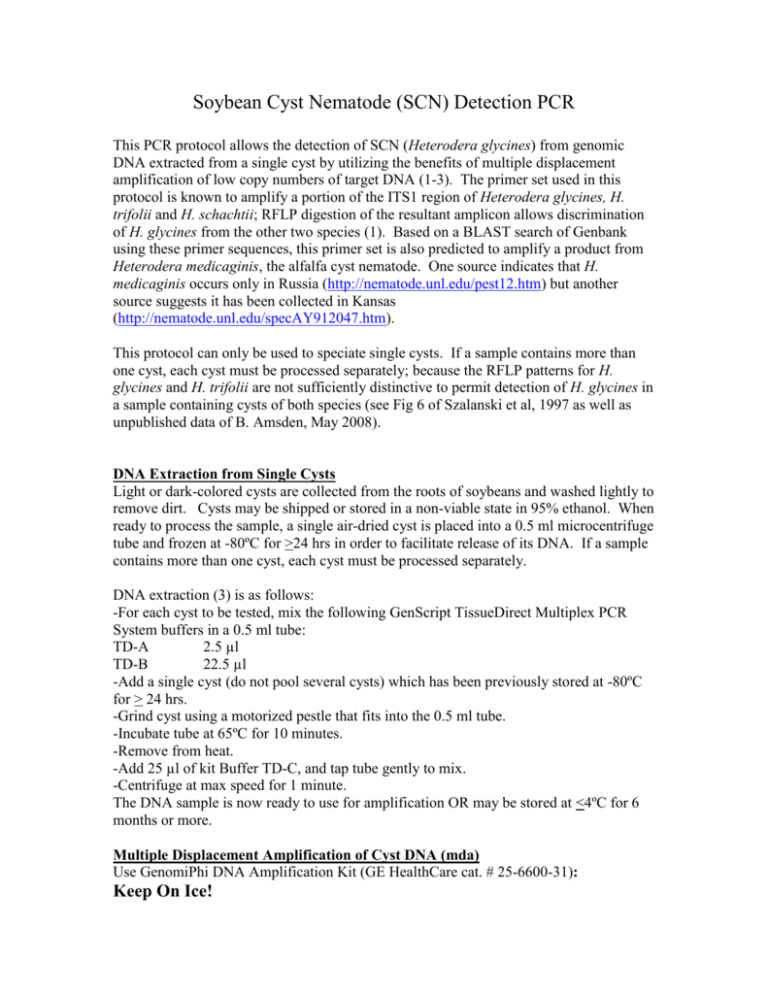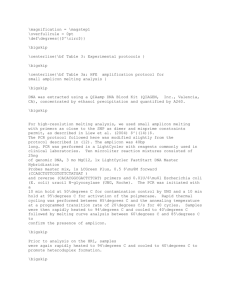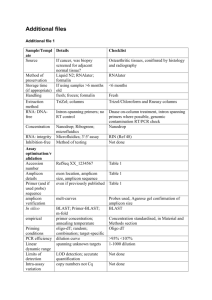Soybean Cyst Nematode Detection PCR
advertisement

Soybean Cyst Nematode (SCN) Detection PCR This PCR protocol allows the detection of SCN (Heterodera glycines) from genomic DNA extracted from a single cyst by utilizing the benefits of multiple displacement amplification of low copy numbers of target DNA (1-3). The primer set used in this protocol is known to amplify a portion of the ITS1 region of Heterodera glycines, H. trifolii and H. schachtii; RFLP digestion of the resultant amplicon allows discrimination of H. glycines from the other two species (1). Based on a BLAST search of Genbank using these primer sequences, this primer set is also predicted to amplify a product from Heterodera medicaginis, the alfalfa cyst nematode. One source indicates that H. medicaginis occurs only in Russia (http://nematode.unl.edu/pest12.htm) but another source suggests it has been collected in Kansas (http://nematode.unl.edu/specAY912047.htm). This protocol can only be used to speciate single cysts. If a sample contains more than one cyst, each cyst must be processed separately; because the RFLP patterns for H. glycines and H. trifolii are not sufficiently distinctive to permit detection of H. glycines in a sample containing cysts of both species (see Fig 6 of Szalanski et al, 1997 as well as unpublished data of B. Amsden, May 2008). DNA Extraction from Single Cysts Light or dark-colored cysts are collected from the roots of soybeans and washed lightly to remove dirt. Cysts may be shipped or stored in a non-viable state in 95% ethanol. When ready to process the sample, a single air-dried cyst is placed into a 0.5 ml microcentrifuge tube and frozen at -80ºC for >24 hrs in order to facilitate release of its DNA. If a sample contains more than one cyst, each cyst must be processed separately. DNA extraction (3) is as follows: -For each cyst to be tested, mix the following GenScript TissueDirect Multiplex PCR System buffers in a 0.5 ml tube: TD-A 2.5 µl TD-B 22.5 µl -Add a single cyst (do not pool several cysts) which has been previously stored at -80ºC for > 24 hrs. -Grind cyst using a motorized pestle that fits into the 0.5 ml tube. -Incubate tube at 65ºC for 10 minutes. -Remove from heat. -Add 25 µl of kit Buffer TD-C, and tap tube gently to mix. -Centrifuge at max speed for 1 minute. The DNA sample is now ready to use for amplification OR may be stored at <4ºC for 6 months or more. Multiple Displacement Amplification of Cyst DNA (mda) Use GenomiPhi DNA Amplification Kit (GE HealthCare cat. # 25-6600-31): Keep On Ice! Step 1 -Mix 1.0 µl of DNA extract with 9.0 µl of sample buffer from kit. -Heat at 95ºC for 3 minutes. - Cool on ice. Step 2 -Amplification Master Mix (make only enough for the number of samples just prior to use): -Mix 1 µl Phi29 DNA polymerase plus 9 µl reaction buffer per # of samples. -Aliquot 10 µl of Master Mix to each tube from Step One. Keep on ice until all are prepared. -Heat tubes at 30ºC for 2.0 hours. -Deactivate enzyme at 65ºC for 10 minutes. -Cool on ice. -Clean mda product using Illustra MicroSpin G-50 Column (GE HealthCare cat. # 27-5330-01). - Store cleaned mda product at -20ºC. PCR Amplification of Soybean Cyst Nematode Amplicon PCR Master Mix, 50 µl rxn NPW, sterile FailSafe Pre-mix A 20 µM primer ITS1-F40 20 µM primer ITS1-R380 AmpliTaq Gold DNA polymerase 18.5 µl 25.0 µl 2.0 µl 2.0 µl 0.5 µl Aliquot 48.0 µl Master Mix per rxn tube Template: Add 2.0 µl of the cleaned mda-amplified genomic DNA from the sample (or control as noted below) Controls: Negative Control: 2 µl Nanopure water Positive Control: 2 µl of known mda-amplified Soybean Cyst Nematode genomic DNA Primers: Prepare to a concentration of 20µM (20 pmol/µl in 1x TNE): ITS1-F40 5’-GTTGGGCTAGCGTTGGCACC-3’ ITS1-R380 5’-CCAGTCAGTGTGTTATGTGC-3’ PCR cycling parameters: 1. 94ºC for 180 sec 2. 40 cycles of: 94ºC 55ºC 72ºC 3.1 cycle Hold: 72⁰C 45 sec 60 sec 60 sec 420 sec Duration of protocol on GeneAmp 9700: 2 hr 50 minutes. Expected PCR amplicon size: 339-341 bp on a 3.5% NuSieve gel w/ 0.5X TBE buffer. RFLP analysis of PCR product Restriction digestion with FokI (New England BioLabs) is necessary to distinguish Heterodera glycine from H. schachtii (sugar beet cyst nematode) and H. trifolii (clover cyst nematode), all of which will amplify a 337-341 bp product using these primers (1). Clean the amplicon prior to restriction digestion using Qiagen’s PCR Purification Kit (Qiagen cat. # 28004). Resuspend the amplicon in 15 µL EB buffer. Digestion with FokI: 20 µL rxn containing 500 ng amplicon. 10X NEB buffer 4 2.0 µL FokI restriction enzyme 0.2 µL Cleaned cyst nematode PCR amplicon 500 ng Sterile nanopure water to final volume of 20 µL Digest at 37⁰C for 2 hours. Stop reaction by either heating at 65⁰C for 10 minutes or by the addition of 2 µl of gel loading dye. Using a 2 mm-thick comb, load the entire reaction volume on a 3.5 % NuSieve agarose in 0.5X TBE gel buffer. Load Invitrogen’s TrackIt 50 bp DNA ladder for sizing of fragments. Expected results of FokI digestion based on Vector NTI-predicted restriction fragment analysis of sequences obtained from Genbank: H. glycines (six entries): Expected amplicon size is 339-341 bp. Two fragments are predicted from a Fok I digestion: one of 263-264 bp, and another of 76-77 bp. H. schachtii (two entries): Expected amplicon size is 338 bp. Fragments from Fok I are expected to be 192 bp, 77 bp, and 69 bp. H. trifolii (four entries): Expected amplicon size is 337-341 bp. Two genotypes were observed: three that yielded Fok I fragments of 192 bp, 77 bp, and 68-69 bp, similar to H. schachtii; and one that produced two fragments: 192 bp and 149 bp. Expected results of FokI digestion based on gel electrophoresis of amplicon digests: Our interpretation of the data presented by Szalanski et al (1) and our own gels (Figure 1 and unpublished) indicate that, while the RFLP pattern for H. glycines and H. trifolii is sufficiently different to distinguish these species when individual cysts are used, the presence of H. glycines in a mixed population of cysts cannot be definitively inferred based on the RFLP pattern. We have observed that H. trifolii amplicon commonly produces a band around 265 bp in size (Figure 1 and unpublished data), which is not expected based on sequences in Genbank. Indeed, we observe a faint but discernible band of this size in Figure 6 of the paper by Szalanski et al (1), although the authors do not comment on this. While it is clear that the two species cannot be distinguished by FokI analysis of a mixed population, their RFLP patterns are sufficiently distinctive to discriminate between these species when individual cysts are assayed. Figure 1. A 3.5 % NuSieve agarose gel in 0.5X TBE buffer, showing FokI-digested amplicons of H. glycines and H. trifolii. Lane 1 (leftmost lane)=Invitrogen’s Track-It 50 bp DNA ladder; lane 2=PCR product resulting from a mixture of H. glycines mdagenerated genomic DNA and H. trifolii mda-generated genomic DNA at a 1:2 ratio; lane 3=same mix at a 1:5 ratio (band distortion resulted from a mishap in loading the well); lane 4=same mix at a 1:9 ratio; lane 5=PCR product resulting from a H. glycines mdagenerated genomic DNA; lane 6-=PCR product resulting from a H. trifolii mda-generated genomic DNA. Figure 2. Fragment sizes provided by Invitrogen’s Track-It 50 bp DNA ladder, for use in evaluating results illustrated in Figure 1. (Figure from http://www.lawrencelab.org/Outreach/2006/trackit.pdf). References: 1. Szalanski et al, 1997. Identification of cyst nematodes of agronomic and regulatory concern with PCR-RFLP of ITS1 J. Nematology 29(3):255-267. 2. Harris, Szalanski, and Powers. “Molecular Identification of Nematodes Manual” 3. This protocol uses a modified version of the Harris, Syzlanski, and Powers Lab Manual in use by Terry Niblack and Ursula Reuter-Carson (email communication). Document Control: 2/15/2016 5:19 PM







